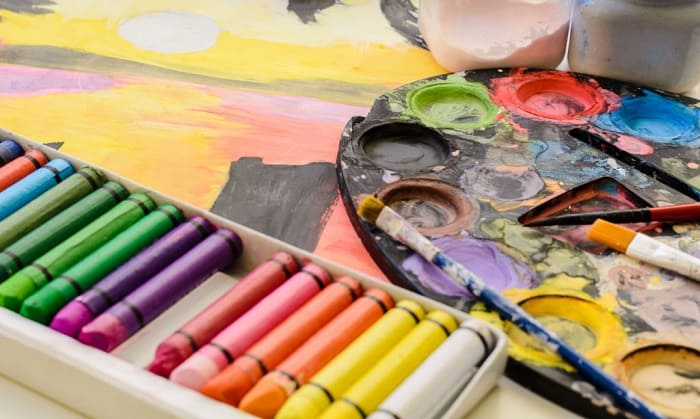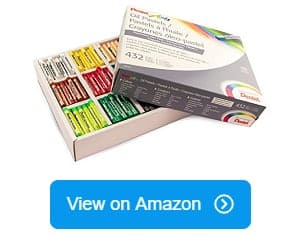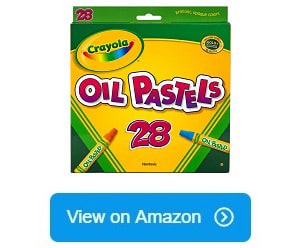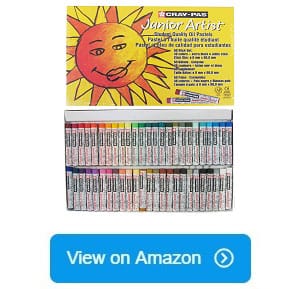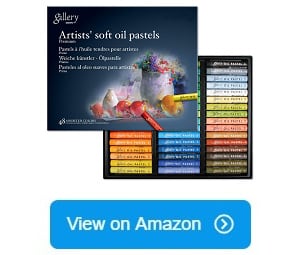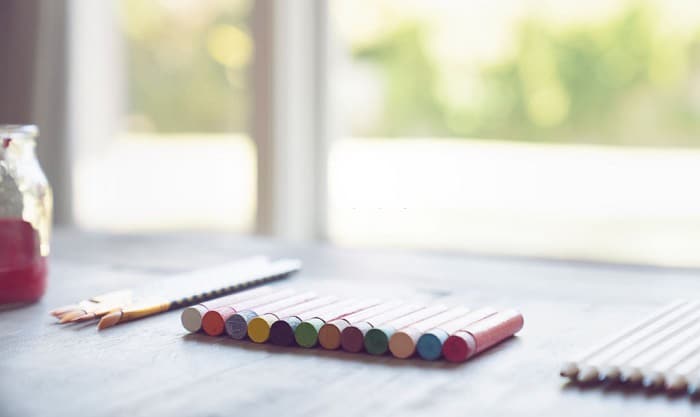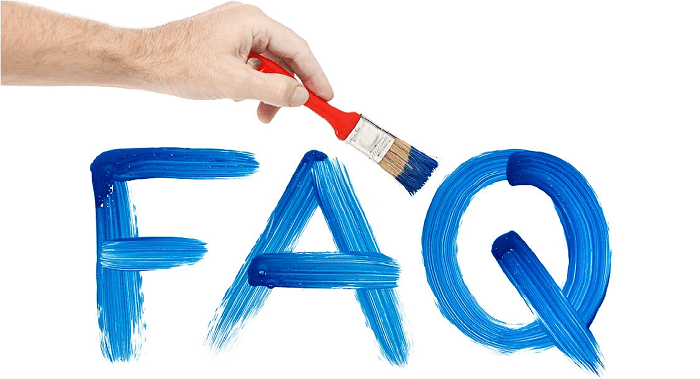Ever you wondered what makes the best oil pastels drawing different among the other types of pastels? It’s all because of their impeccability in the bright and intense hues. The highly pigmented cylindrical sticks render a distinctive waxy consistency that produces smooth and buttery application. Basically, oil pastels are sturdy, reliable, and exceptional creative tools you’d probably need in your art stash right now.
But this leads you to the next question: how should you choose your first, if not, your next set of oil pastels? What are the significant factors and features you should know about?
Fortunately, you’ve come to the right place. As you read on, you’ll find everything you need to know about oil pastels. I’ve also prepared a roundup of the top-selling oil pastels on the market to narrow down your options.
Table of Contents
- Top 10 Oil Pastel Reviews
- 1. Pentel Arts Oil Pastels
- 2. Crayola Oil Pastels
- 3. Sakura Cray-Pas Oil Pastels
- 4. Mungyo Gallery Soft Oil Pastels
- 5. Crayola Oil Pastels Portfolio Series
- 6. PRO ART PRO-3014 Oil Pastel
- 7. Sakura XLP50 Oil Pastel
- 8. Loew-Cornell Oil Pastels
- 9. Caran D’ache Neopastel Artist Oil Pastels
- 10. Sennelier Oil Pastel Intro
- What to Look for When Buying Oil Pastels
- Frequently Asked Questions
- Conclusion
Top 10 Oil Pastel Reviews
1. Pentel Arts Oil Pastels
One best Pentel oil pastels review is it highlights all the possibilities you can do with an oil pastel set. Packed with 432 pieces of vibrant and versatile oil pastels, you’ll have a massive collection of colors to mix and play with!
While this may seem an overwhelming selection for some artists such as amateurs, need not worry as these stunning colors are easy to use. They are blendable, and each color showcases bright, vivid shade that you can apply to blend with other colors for subtle, soft tints and shades.
It’s all about versatility in performance and ideal selection ranges. These oil pastels are suitable for all ages, from beginners, advanced users or professional artists. Therefore, if you’re looking for the right oil pastel paintings for children, students, hobbyists, and professional oil pastel artists, these pastels will do the job. They are also suitable for multiple types of surfaces, especially board, paper, and canvas.
As manipulated from acid-free, these oil pastels are able to last long without easily wear out. I find this factor highly significant since it can preserve the quality of your artwork, keeping the colors vibrant at the original status for a long time.
What I also like about these oil pastels is how you can easily blend them even with your fingers. Smear or smoothen them out, and then colors render great payoff. These oil pastels are workable and you can even let your kids enjoy mixing and blending the colors!
- Versatile and highly blendable
- Easy to work with different oil pastel techniques
- Suitable for multiple types of surfaces
- Acid-free for long-lasting quality
- Vibrant and bright colors
- Ideal for beginners and professional artists
- Has smelly chemical odor
- May feel a bit hard and rough at first
2. Crayola Oil Pastels
For oil pastels that young artist aspirants, students, and children can enjoy, these colorful pieces from Crayola will do the trick. The oil pastels are crafted for rich color and creamy texture, giving smooth drive as you apply it to the surface.
Designed with ergonomic and easy grip, those young artists and little hands can take delight in these amazing colors. They can produce subtle hues, blended shades, and vibrant pop of colors to their artwork. Whether you are making posters in your art class or simply creating your first ever oil pastel masterpiece, these oil pastels are convenient to use and blendable.
Another noticeable feature I like is the pointed tip, which makes the oil crayon pastels look like regular crayons. The pointed tips are great for detailed lines and strokes. Plus, such a feature makes the oil pastels a lot easier to use, especially for the kids! These are non toxic oil pastels and hence, ideal for young kids ages 3 years old and up.
The colors are stunning and contain a high level of pigment that gives off great output. The blending ability also goes smoothly. With its brightness and vibrancy, producing solid blocks of colors is easy as a breeze.
- Features pointed tips for precise detailing
- Offers vibrant and bright colors
- Easy to use and blend with other colors
- Ideal for beginners and children
- Non-toxic ingredients for safe use
- Lends creamy texture and smooth application
- Layering the colors can be a bit difficult at times
3. Sakura Cray-Pas Oil Pastels
Sakura offers a vast lineup of oil pastels that target beginners, students, and advanced users or professional artists. But if you’ve just been learning your ways and techniques with oil pastels, this Junior Artist set could be the ultimate gift for your artistic skills!
This cray pas oil pastels review unravels the properties that every artist can take advantage of, creamy texture and smooth and blendable colors.
This student quality oil pastels are carefully crafted to make oil pastel painting smooth and easy. Each oil pastel features a soft texture that renders seamless and effortless application. Embellished with highly pigmented and bright colors, I like how you can mix and play with them by the technique of your choice.
Whether you’re layering, finger blending, embossing, scraping down the colors or using a sgraffito technique, these oil pastels are just right for the job. I find the pastels pretty impressive with their workable textures that you can also use for impasto effects.
Thanks to the texture, the colors are easy to blend without eliminating the consistency. They don’t get messy when you smudge or smoothen them out.
What I also like about these oil pastels are the ingredients that meet non-toxicity requirements; they are safe to use. Comes in a 50-piece set, you will have enough range of colors to work with.
- Student quality oil pastels
- Lends smooth and soft texture for easy application
- Offers vibrant and bright colors
- Versatile and easy to blend
- Ideal for beginners
- Non-toxic
- The oil pastels are smaller than usual
- Poor packaging
4. Mungyo Gallery Soft Oil Pastels
Mungyo Oil Pastels are professional quality oil pastels that render rich and vibrant that will give your artwork lifelike colors and artistic effects. The colors are highly pigmented that you can get the tints or right shades with just a few strokes.
Try it out for a quick swatch to see how intense the colors are right off the bat. With exceptional coverage, these pastels are ideal for impasto effects or sgraffito or scraping. This beautiful set has a smooth and soft texture that professional artists would love. It becomes especially when you want to blend them for creating subtle hues and precise combinations of colors.
As being designed to be low-residue, it can keep your artwork neat at all times. I see that these oil pastels let you create art projects without leaving any messy residues or dust. Although labeled as soft oil pastels, I am impressed with their durability. It maintains the softness and smoothness without breaking easily.
They do not crumble but still lends that soft texture that spreads like butter to the surface. While these are professional high quality oil pastels that may require some techniques and skills, beginners may also give them a try. Luckily, these oil pastels are easy to use. Plus, you’ll find a great value for money with this 48-piece set.
- Highly pigmented pastels for intense and rich colors
- Very versatile and can be used with different techniques
- Highly blendable and easy to work with
- Designed as soft oil pastels but don’t break easily
- Renders smooth and soft drive as you use it
- Does not leave any residues
- Ideal for professional artists
- There’s a little patchiness on some light colors
5. Crayola Oil Pastels Portfolio Series
If you often work with different art mediums, you’ll probably find this Crayola Oil Pastel Set a wonderful treat. Unlike typical oil pastels, these Portfolio Series are water-soluble and therefore, allow you to work with a wet paintbrush and make them work like watercolor drawings. You’ll have both worlds with these oil pastels whether dry or watercolor textures.
I also notice the pointed tips which are quite contrary to conventional oil pastels designs that have flat edges. I think such a feature is very useful for rendering detailed strokes and lines, which is somehow a bit difficult to execute when working with creamy oil pastels.
This set, moreover, offers an array of stunning and vibrant colors that are highly blendable, especially if you want to make subtle shades or intense tints. With just a few strokes, you can also build the color heavily and give them a smear or smudge to carry out dramatic and artistic effects.
These versatile oil pastels are also easy to use. Whether you are a professional artist or crafter or an amateur in oil pastel painting, these oil pastels could be a good set to start with. Each color provides superior performance and quality without breaking your bank.
They aren’t too waxy and also do not dissolve too quickly. These pastels are non-toxic and can be used by children to help them enhance their creativity.
- Water soluble oil pastels
- Has pointed tips for precise detailing
- Very vibrant and highly blendable pastels
- Versatile and can be used with different oil pastel techniques
- Offers creamy texture and smooth application
- Non-toxic
- Ideal for beginners and professional artists
- A little bit difficult with other water crayons
6. PRO ART PRO-3014 Oil Pastel
For good oil pastels that you can use for heavy and light pressure blends or producing subtle shades of your pastels, white oil pastels might just complete your arsenal. This 12-piece set would be enough to help you develop multiple shades in your work.
With a creamy texture, these pastels go on easily on the surface. They are also easy to use, making them a good choice for beginners. Another characteristic I like is its versatility. You can give them a nice stroke and deliver various textures and color combinations using different oil pastel techniques.
These white oil pastels are great to use for textural strokes and building colors with softer hues. With its high pigment content, these white oil pastels do not overshadow vibrant colors but rather blend in very well to create an array or layer of colors.
- Renders soft and creamy texture for easy application
- Can be used with different oil pastel techniques
- Very pigmented
- Can be used to create subtle shades and softer hues
- Great for textural strokes and building colors
- They can get a little messy at times
- Poor packaging
7. Sakura XLP50 Oil Pastel
If you’re looking for oil pastels that can compete with professional-grade quality pastels, these Sakura oil pastels are a great contender. Don’t confuse this Expressionist set from the Specialist collection that is specially crafted for serious artists and professional painters.
Fortunately, this 50-piece set does not fall behind in quality but rather an upper grade for student quality oil pastels.
These oil pastels are excellent, easy to blend, great to use for sketching and drawing. The colors are sublime and reasonably opaque. You can take advantage of the highly pigmented shades, particularly the greens, blues, and earth tones that can be applied for efficient color blending. I’m also impressed with the metallic gold and silver colors that are included in the palette.
Another fascinating feature of these oil pastels is the versatility. I like how you can let it work on a wide range of surfaces such as canvas, paper, cardboard, and even wood.
You can play with the colors and produce various textures and shades, whether on a portrait, an abstract, still-life, stenciling, scratch arts, etc. These oil pastels are also safe to use due to their non-toxic ingredients.
- Excellent student-quality oil pastels
- Versatile and suitable for a wide range of surfaces
- Easy to blend can be used with different types of techniques
- Highly pigmented shades for bright and vibrant hues
- Non-toxic
- Ideal for beginners, hobbyists, and serious artists
- Some colors in the set don’t seem to apply evenly
- The size seems a little bit smaller than usual
8. Loew-Cornell Oil Pastels
If you are an aspiring oil pastel artist and have just been learning how to use these bright and highly pigmented colors, you can give these Loew-Cornell oil pastels a try. This 60-piece oil pastel colour set might seem an extensive collection but these pastels are workable and easy to use.
These non-toxic oil pastels are innovatively crafted to provide great quality performance for learners and oil pastel amateurs, particularly kids and young students. They feel soft and smooth as you apply it to the surface.
What I also like about these pastels is how you can easily work with different surfaces. You may choose between pastel paper, board, canvas, textile, plaster, cards, and many more.
Smaller in size compared to other oil pastels, they can be gently sharpened to use the tips or edges for detailing and creating refined lines and strokes. Surprisingly, they don’t easily crumble. Plus, these pastels come at a very affordable price, leaving you nothing to worry about when shaving them off, unlike high-priced oil pastels.
While they may fall under a low pricing mark, you will still get a great value for your money with 60 oil pastels. That’s definitely a steal. I find the colors very vibrant and in great quality, something you won’t expect with cheaper oil pastels. But these do deliver and can keep up with the quality of oil pastels, particularly for beginners.
As these amazing colors render great color payoff when you combine them or scrape them down, they do the trick to give your artwork vibrant shades. It’s safe to say that this brand is one of the best oil pastels for beginners.
- Formulated with non-toxic ingredients
- Showcases vibrant and bright colors
- Easy to use; ideal for beginners
- They don’t easily crumble and break
- Can be used on different surfaces
- Great value for money
- The packaging looks flimsy
- Can be difficult to blend at times
9. Caran D’ache Neopastel Artist Oil Pastels
Caran D’ache boasts its highly pigmented oil pastels that render excellent color payoff. It’s not an issue whether you’re blending them with a tool or your fingers, or scraping them down to create textures and details to your artwork.
Even when you mix and overlay the colors, these oil pastels do not get muddy and messy. I like how you can revamp the layers of colors to your art and smudge them beautifully for softer hues and more dramatic effects.
Packed in 12 vibrant oil pastel sticks, you’ll have enough with the basic colors, especially if you are still working on your skills and techniques. While these amazing pastels stand out with their rich pigment, they also highlight their soft and velvety texture that feels smooth and easy as you apply it. It feels like spreading butter when defining the shades and creating strokes to modify the effects.
What’s also great about these oil pastels is their versatility. You can use these oil pastels with turpentine as they are soluble, especially if you are looking for oil pastels for canvas. Whether you are a student or an art teacher, you can showcase your techniques and artistic combinations like blending, sgraffito, layering of colors, lines, or flat-wash.
With a size of 10mm diameter, these oil pastels don’t fall short on covering wider areas. They do deliver and can cover multiple square inches of your work, allowing you to get your art project done in no time. The colors are stunning and incredibly opaque. They’ve got exceptional lightfastness so they don’t easily wear out unlike cheaper kinds of oil pastels.
- Renders excellent lightfastness and very opaque basic shades
- Delivers smooth and soft application
- Versatile and can be used for applying different kinds of techniques
- Lends beautiful blends of colors without leaving any messy edges
- Resistant to heat and water and non-drying
- Soluble and can be used in turpentine
- The range of colors for this set is limited
- Not a artists oil pastel
10. Sennelier Oil Pastel Intro
This 12-piece set of Sennelier oil pastels is a versatile medium that’s been a favorite among professional artists and painters. With an exceptional standard of quality, these oil pastels showcase incredible opacity, soft quality, and high-quality performance. Hence, if you are looking for professional quality oil pastels, this might be the ideal pick for you.
I love how these pastels carry out what oil pastels should be: creamy, soft, and smooth. You can work on it easily and the pastels glide seamlessly and effortlessly as you apply it to the surface. I find the texture pretty impressive; therefore, allowing you to manipulate the colors and come up with your favorite color combinations.
In terms of the application of techniques, these oil pastels are workable. You can use them for different types of blending to produce textures and vibrant colors. Use it with the smudging technique, and you can easily spread the colors to create soft shades and artistic effects. Crafted with a great range of rich and intense colors, you can give your artwork vibrant mixtures of shades.
If you’re working on a mixed medium such as watercolor, these oil pastels can be used as a resist. In this way, you can enhance the quality and textures of artwork by defining strokes and producing softer hues.
- Professional-grade quality oil pastels
- Creamy, smooth, and easy to work with
- Glides effortlessly and seamlessly to the surface
- Can easily be used for smudging and blending the colors
- Workable and versatile
- The size of the pastels seem smaller than usual
- Feels too soft which may not be ideal for detailing
What to Look for When Buying Oil Pastels
Selection of Colors
The wide selection of vibrant colors of oil pastels is always a feast in the eyes. Luckily, these oil pastels are often available in different sets; therefore, allow you to come up with your choice of a color palette. These oil pastels may come in assorted colors or single shades.
You can find them in sets of 12, 16, 24, 25, 48, and 50. Surprisingly, there are manufacturers who offer extensive collections of oil pastels that may range between 200 to 400 and sometimes more.
In terms of making your choices, you have to consider your skills, techniques, and projects you would be working on. Oil pastels are special types of creative tools and not like your regular crayons.
Therefore, if you’re a beginner and still working on your skills, you may opt for fewer colors. The extensive selection of oil pastels can be a bit difficult to work with unless you’re an experienced oil pastel artist who looks for more shades to add in your collection.
Versatility
It is important to know how your oil pastels would perform. If you often work on different types of art surfaces and mediums, make sure that your oil pastels have the versatile features to adapt to your preferred materials. Those surfaces can be normal papers, pastel papers, cardboard, canvas, or wood, etc.
It would be nice if the oil pastels are easy to blend. This makes it easier for you to produce a variety of shades and tints. You can go from vibrant shades to subtle hues to amplify your work with realistic or artistic effects. On the other hand, some oil pastels are water-soluble which allows you to use them as watercolor pastels at the same time.
Another fascinating point of their versatility is how these pastels let you create impasto effects to highlight the details of your art. You can also ramp up the quality of your oil pastel painting by using a solvent such as turpentine. With such substance, you can speed up the drying process of the pastels. To blend the colors, you can also use a cotton ball or q-tip.
The Opacity of Colors and Ingredients
Oil pastels never cease to impress with their bright and opaque colors. But if you want to take home a set of high-quality oil pastel colors to your arsenal, it would still be better to check the opacity of colors. There are pastels that showcase rich and fade-resistant colors for long-lasting quality.
Those labeled acid-free are oil pastels that can resist the adverse effects of humidity on the drawing. Hence, these oil pastels don’t easily fade as well. You may check the customer reviews regarding this to get some sneak peeks of the colors and on how they look on different types of surfaces.
Aside from the vibrancy of the colors, you may also consider checking the ingredients to make sure the oil pastels are safe to use. This is also a prerequisite for checking any oil pastels, especially if you’re going to let your kids and young ones use them for artworks. You should check if the product is labeled as non-toxic oil pastels or do not contain any ingredients that may cause any harmful effects.
Quality and Textures
One of the distinct features of oil pastels is their waxy consistency. With this texture, using it on a surface feels smooth and soft, making shading, blending, and rendering strokes a lot easier. They also easily spread, apparently because of the oil. But these oil pastels are stable and hence, fixatives are not necessary. However, if you still want to learn how to use fixative for pastels, check our guide on the top-rated fixative for pastels.
What’s also great about these oil pastels is their sturdy quality. Contrary to oil pastel pencils that may sometimes easily break or leave dust, oil pastels don’t smudge, crumble, or leave any particles, keeping your artwork neat at all times.
Brand Reputation
There’s no question that you want to invest in artist quality oil pastels. If you’re working on a large scale project that requires more colors, perhaps you want to replace your old set oil pastels or look for your first set of oil pastels to practice your skills, one of the significant factors you probably consider is the brand.
When you are in doubt of which sets of oil pastels to purchase, going through the list of popular and reputable brands could be an effective and easy trick. There is a vast array of art brands that offer exceptional lineups of art materials such as oil pastels. With their expertise in the industry, they’ve already established a trustworthy name and service that can provide high-quality, durable, and reliable materials.
This factor also helps you narrow down your options and sort out which brands stand out on the market. On our list, you’ll find different types of brands that have been deemed to excel in producing some of the finest oil pastels you can find on the market today.
Your Preferences and Needs
The next thing to do on your checklist is to determine your preferences and needs. This helps you identify what kind of oil pastels and how many colors you should opt for. If you are a beginner and still working on your skills, there are oil pastels for students that typically come in affordable sets but with great quality.
Professional oil pastels are also available for artists and art enthusiasts who have been quite familiar with oil pastels. You can also find them in a wide range of colors and prices. If you’re used to working on large scale projects and a vast array of colors, extensive collections of oil pastels might just be the ideal pick for you.
Besides the quality and type of oil pastel sets, you can also determine your choices when it comes to your skills and techniques. Working with different types of art mediums is also a significant factor. It would also help if you can identify the capacity of your project and what shades you usually work on. In this way, you can decide how many and which set of colors you should buy.
Price Range
When you’re all set with your preferences, the next important thing to consider is the price range. How much are you willing to invest in a set or sets of oil pastels? These playful colors of pastels are available in a vast range of price tags. If you are looking for pastels that won’t break your bank, there are cheap oil pastels that still offer great value for your money.
You may also consider browsing e-commerce websites or online stores for seasonal deals. You’d be lucky enough to find good quality oil pastels with marked down prices or modified deals. If you want to save on cost, you can browse between brands or start with sets of oil pastels with fewer colors. Do know that these factors have a significant effect on the price.
What are oil pastels?
From the waxy consistency and creamy texture, oil pastels have become a favorite among many artists. They resemble oil paints and can even create impasto effects when colors are heavily built. They showcase a versatile quality that can deliver superb effects on different surfaces while applying various shading techniques and drawing or skills of building colors. Let your hand work on it and it’ll deliver a smooth application.
These cylindrical sticks of vibrant and bright hues have exceptional stability. These oil pastels don’t crumble or break easily and even smudge. You can also keep your work neat and free of any dirt as these pastels don’t leave any particles or dust.
They are impeccably vibrant and most of the time, a little goes a long way. However, painting with these oil pastels isn’t too difficult and with lots of practice, you can come up with a masterpiece!
How do they work?
It is the merge of oil and wax that keeps these oil pastels intact. They may have a look or feel of regular crayons but techniques and positioning of your hands and fingers are the keys to make these pastels work. You can use the tip or edge of the oil pastel or you can lay it flat on the surface as you use it on your preferred material like canvas, paper, cardboard, or wood.
Oil pastels stand out with their creamy and smooth texture, making them easy to work with. Its distinct consistency renders seamless and soft strokes without leaving any dirt and dust. These pastels have amazing versatility, allowing you to produce layers of colors and come up with different depths of colors.
One of the common techniques used with oil pastels is scraping down or also known as sgrafitto. However, they are a bit difficult to blend with compared to soft pastels and hard pastels as well. But with their vibrant shades, you can let them do the trick to enhance your art with dramatic and realistic effects.
Who are these for?
If you’re an experienced artist who loves oil pastel paintings, oil pastels are definitely meant for you. But these colorful and vibrant oil pastels are also crafted for beginners who want to upgrade their skills and techniques. Basically, oil pastels are for art enthusiasts, students, art aficionado, and children or adults who are passionate about creating pieces of art and paintings out of different art mediums such as oil pastels. If you are any of these people, oil pastels must be for you, too!
What are the different types of oil pastels?
Oil pastels or oil based pastels are another form of pastels and deemed to be a fast art medium as they are easy to work with. They offer flexibility in terms of building and layering colors that can produce different kinds of effects. These amazing art tools are known for their creamy texture and rich colors that can render soft and smooth strokes.
You can also work with oil pastels and enhance the effects through different types of techniques. The outcome of your artwork has significance to the quality of oil pastels you’re using. Typically, oil pastels don’t actually come in a variety of types but we may categorize their differences based on their texture and quality. These characteristics, moreover, may vary according to the brand.
There are professional-grade oil pastels that are specially and innovatively crafted to meet the standards and requirements of professional artists or painters. You may find these types of oil pastels on some brands. If you’re a beginner and just starting with oil pastels, there are student quality or student-grade oil pastels that can keep up with your skills and techniques. They also usually come in a cheaper pricing mark.
Some artists or art students determine oil pastels according to their textures and application. Sennelier oil pastels, for example, are known for their rich and creamy texture that spreads like butter on a surface. Soft oil pastel sets such as from this brand may be an ideal option for those who wish to manipulate the colors and perform an effortless application.
Why do you need oil pastels?
You need oil pastels because they are versatile, workable, and showcase exceptional durability that doesn’t break easily and crumble. If you want to create a masterpiece with art tools that resemble oil paints, oil pastels are what you should seek after. If you are new to oil pastels, you’d be happy to know that they are convenient to use and considered as a fast art medium.
They look like crayons and may somehow have the same feel because of its waxy consistency. But this makes them workable, allowing you to take delight in its soft texture to create effects and layers of colors.
These oil pastels are not difficult art mediums although they may not always be easy-breezy when using them for the first time. Nonetheless, oil pastels are probably what you need for an artwork or painting that depicts lifelike and vibrant colors.
Frequently Asked Questions
What are the most trusted oil pastel brands?
With the overwhelming options of brands for oil pastels, picking out the best one might be a bit challenging. But just like the ones mentioned in our oil pastel review, some of the popular and reputable brands that you can check out are Sennelior, Crayola, Pentel, Caran D’ache, and Sakura.
These brands have been widely recognized for their respective distinct features such as texture and quality. Sennelior is one of the popular brands for professional quality oil pastels while Sakura offers lineups of oil pastels that capture both beginners and professional artists.
Loew-Cornell oil pastels, on the other hand, could be the ideal brand for you if you’ve just started with oil pastel painting. Such a brand offers collections of oil pastels that target beginners and children. In terms of price, they’re also more affordable compared to other brands.
If you’re looking for professional-grade pastel colors, you may check out Holbein oil pastels. This brand showcases stunning collections of colors that have been widely patronized by many artists across the globe. These oil pastels have unique characteristics that makes them a favorite among art enthusiasts and professional artists who deliver artworks crafted with various techniques.
On the other hand, your ultimate choice always depends on your preferences and needs. The best brand is not always the most popular or the most expensive but the one that keeps up with your skills, experience or level, and techniques.
Which is better – oil pastels or soft pastels?
It’s hard to tell which pastels are better. Perhaps, you can only tell depending on which quality and texture you need and prefer. Each type has its share of pitfalls and advantages. Oil pastels have waxy consistency and don’t easily break or crumble. They are durable, versatile, and great for sketching and producing artistic effects. They render smooth and soft strokes because of its creamy texture.
Soft pastels, on the other hand, are more popular. Unlike oil pastels, you can easily blend and layer the colors. Compared to oil pastels, soft pastels are great to use for detailing your artwork with fine lines and strokes. But if you wish to refine your work with dramatic details and effects, you can easily smudge them.
However, soft pastels are more fragile. They tend to crumble or break easily, leaving dust and particles on your work. Despite their differences, oil pastels and soft pastels are beautiful sticks of vibrant colors. They are also easy to work with. Both types may demand your patience and effort as you work on your skills and techniques. But they guarantee rich colors that you can build and layer to create amazing artistic works.
What kind of paper is best for oil pastels?
It is best to use papers that are specially designed for oil pastels. You can purchase pastel papers or pastel cards or cardboards to use as the surface for your oil pastels. Therefore, the heavier the surface of the paper is the better. Because of the oil content, it is not recommended to use a normal paper or a sketch paper for oil pastels. As normal papers are typically thin, oil pastels may just get through it and just stain the paper.
How to use oil pastel?
Oil pastels may resemble crayons but they work differently. There are a lot of techniques you can apply to create the art project or painting you want. Do know that the position of your hands and fingers may vary from one person to another. It all depends on which position you’re comfortable with and which techniques you’re using. But to give some ideas on how you can use oil pastels, you may jot down the following tips:
- You should prepare your preferred surface first. It is better if you’re using a paper or card specifically designed for oil pastels. These papers are typically heavier than ordinary papers.
- You can use the edge or tip of the oil pastel for sketching or shading. Typically, your forefinger and thumb are taking the lead. Any sides of your hand or palm do not touch the surface.
- For wider coverage when shading, some artists prefer laying the pastel down onto the surface using the same hand position.
- For blending colors, you might want to start with darker colors and lighter colors after. To show ombre effect or color fading, you can start with the darker color and heavily build it up by pressing your hand hard. As you keep on shading, go lightly as you reach toward the end of the shade.
To amplify the effect, you may use a light color such as white, and start shading from the lightest part of the dark color. You can try this technique with any combination of dark and light colors.
- If you want to try a heavy-pressure blend, you may choose your preferred combination of colors, usually in dark colors. Red and blue, for example. With this technique, the lightest shade of the colors will merge, creating a softer shade of a new color. With red and blue, you should be able to come up with purple color as they jive.
To do this technique, you can start building the red color by pressing your hand hard to produce a heavy color. Let’s say you start from the left to the right. Do the same thing with the blue color but coming from the other side, from right to left. As the colors meet at the center, the colors will combine and come up with a new color.
- You may also try a light-pressure blend for softer hues. Same steps as the previous technique but with lighter pressure on your hand.
- Another way to use your oil pastel is with stippling. This technique is like how you form or write dots, creating a stippled effect. This technique is better with more colors. You can choose any combination of colors you like or any subject you want to draw.
- Scumbling is another technique you can try. As the name suggests, you’re just scumbling the lines to create textures and effects. No specific directions are required. Using your oil pastels, you can produce layers of colors from the opaque part of the colors to the lightest.
- Sgraffito or scraping down is one of the most common techniques that you can do. You can use combinations of colors and make sure to start with the lightest and put the darker color last or on top.
Find a tool with a sharp tip or edge that you can use to scratch into it or to scrape the color down. You may use a palette knife or popsicle stick. Scratch into it with whatever design you want.
How can I make my oil pastels blend better?
You can try various techniques to carefully blend your oil pastels. One of the simplest ways is to use a tissue paper, a cotton ball, a soft cloth, or a q-tip to modify the shades for a much softer looking. Using this technique, you can easily blend the colors and produce more artistic effects.
Scumbling method is another way to combine the colors and overlay them. With such a technique, you can also manipulate the colors and textures. Keep on scribbling the colors and lines until you achieve the shades and images that you want.
If you have paint or art tools to use such as brushes or shapers, tortillions or stumps, and an eraser, you may use them to blend the colors according to your preferred hues. Remember to do it carefully. You may try it first on a small portion of your oil pastel work to prevent any mess and mismatch of colors.
If you’ve got nothing else to use, your fingers can also be reliable blending tools, especially in larger areas. Just make sure to wash your hands or wipe the colors off thoroughly to keep your artwork clean and prevent wrong shades from mixing.
Where to buy oil pastels?
Oil pastels are very accessible. You can purchase them in almost every art shop you can find. These oil pastels usually come in sets and various ranges of colors and you may choose which set best suits your needs and preferences.
If it is not possible for you to visit any of the stores in your neighborhood, you can also purchase these oil pastels with just a click away. Fortunately, most of the manufacturers sell sets of oil pastels through e-commerce websites such as Amazon or eBay. You can select your favorite sets among the vast lineup of oil pastels and customize your purchase according to your preferred number of colors.
Now and then, these websites offer seasonal deals and discounted prices that you can take advantage of and save up more for other supplies you need!
How to care and clean oil pastels?
Sharpening your oil pastels isn’t always necessary. But to keep them in their best condition, you should always put them away in a case to prevent them from breaking and other damages. Because of the oil and their waxy consistency, oil pastels tend to mix easily with colors, especially when you’re combining or blending them with other colors.
To remove some stains or other colors on your oil pastels and restore them to their original shades, particularly on white oil pastels, you may use a clean soft tissue, a cotton ball, or soft cloth to clean them up every after use.
Conclusion
To sum it up, finding the best oil pastels doesn’t have to be a struggle. It may take a bit of research and comparison but with the help of our oil pastels reviews and in-depth guide, you will find out everything you need to know about oil pastels.
You should consider the selection of colors, versatility, texture, and quality of the oil pastels, then figure out which set of oil pastels best suits you. It would also help if you take note of the brand and price range, especially if you’re just starting with oil pastels. But with the proper application of techniques, you’ll be able to come up with artistic works crafted with vivid hues and beautiful textures!

I am a former art teacher, so it is evident to me the importance of art in educating the new generation. We also want to help parents who plan to teach their children and desire the best tools and tips for them.
